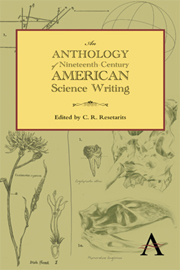Book contents
- Frontmatter
- Contents
- Preface
- Part One 1800–1846 Naturals and Naturalists
- Part Two 1846–1876 Warriors
- Part Three 1876–1900 Scientists
- Part Three Introduction
- “The Fixation of Belief” (excerpt), Popular Science Monthly (1877)
- “How to Make Our Ideas Clear” (excerpt) Popular Science Monthly (1878)
- “Catastrophism and Evolution” (excerpt), The American Naturalist (1877)
- “The Spectrum of an Argand Burner,” Science (1883)
- “The New Astronomy. I. Spots on the Sun” (excerpt), The Century (1885)
- “Screw,” Encyclopedia Britannica, vol. 21, 9th edition (1875–1889)
- “On the Relative Motion of the Earth and the Luminiferous Ether,” American Journal of Science (1887)
- “The Lake as a Microcosm” (excerpt), Bulletin of the Peoria Scientific Association (1887)
- “Laws of Temperature Control of the Geographic Distribution of Terrestrial Animals and Plants,” National Geographic Magazine (1894)
- “The Ecological Relations of the Vegetation on the Sand Dunes of Lake Michigan” (excerpt), Botanical Gazette (1899)
- “On the Equilibrium of Heterogeneous Substances, abstract,” American Journal of Science and Arts (1878)
- Bibliography
“How to Make Our Ideas Clear” (excerpt) Popular Science Monthly (1878)
from Part Three - 1876–1900 Scientists
Published online by Cambridge University Press: 05 June 2012
- Frontmatter
- Contents
- Preface
- Part One 1800–1846 Naturals and Naturalists
- Part Two 1846–1876 Warriors
- Part Three 1876–1900 Scientists
- Part Three Introduction
- “The Fixation of Belief” (excerpt), Popular Science Monthly (1877)
- “How to Make Our Ideas Clear” (excerpt) Popular Science Monthly (1878)
- “Catastrophism and Evolution” (excerpt), The American Naturalist (1877)
- “The Spectrum of an Argand Burner,” Science (1883)
- “The New Astronomy. I. Spots on the Sun” (excerpt), The Century (1885)
- “Screw,” Encyclopedia Britannica, vol. 21, 9th edition (1875–1889)
- “On the Relative Motion of the Earth and the Luminiferous Ether,” American Journal of Science (1887)
- “The Lake as a Microcosm” (excerpt), Bulletin of the Peoria Scientific Association (1887)
- “Laws of Temperature Control of the Geographic Distribution of Terrestrial Animals and Plants,” National Geographic Magazine (1894)
- “The Ecological Relations of the Vegetation on the Sand Dunes of Lake Michigan” (excerpt), Botanical Gazette (1899)
- “On the Equilibrium of Heterogeneous Substances, abstract,” American Journal of Science and Arts (1878)
- Bibliography
Summary
Whoever has looked into a modern treatise on logic of the common sort, will doubtless remember the two distinctions between clear and obscure conceptions, and between distinct and confused conceptions. They have lain in the books now for nigh two centuries, unimproved and unmodified, and are generally reckoned by logicians as among the gems of their doctrine.
A clear idea is defined as one which is so apprehended that it will be recognized wherever it is met with, and so that no other will be mistaken for it. If it fails of this clearness, it is said to be obscure.
This is rather a neat bit of philosophical terminology; yet, since it is clearness that they were defining, I wish the logicians had made their definition a little more plain. Never to fail to recognize an idea, and under no circumstances to mistake another for it, let it come in how recondite a form it may, would indeed imply such prodigious force and clearness of intellect as is seldom met with in this world. On the other hand, merely to have such an acquaintance with the idea as to have become familiar with it, and to have lost all hesitancy in recognizing it in ordinary cases, hardly seems to deserve the name of clearness of apprehension, since after all it only amounts to a subjective feeling of mastery which may be entirely mistaken.
- Type
- Chapter
- Information
- An Anthology of Nineteenth-Century American Science Writing , pp. 212 - 218Publisher: Anthem PressPrint publication year: 2012
- 2
- Cited by



